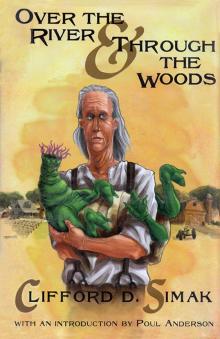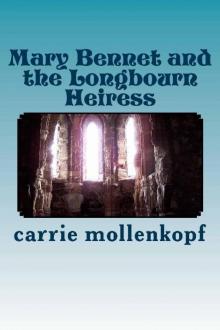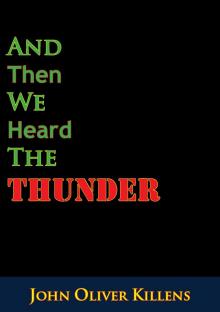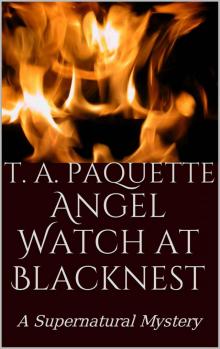Over the River and Through the Woods


Author: Clifford D. Simak
Category: Other
Published: a long time ago
Series:
View: 397
Read OnlineThis groundbreaking retrospective collection features the classic science fiction stories of Clifford D. Simak (1904-1988). When the Science Fiction Writers of America began bestowing their Grand Master awards, Simak was the third writer so honored. Only Robert Heinlein and Jack Williamson preceded him, and he received his award before such luminaries as Fritz Leiber, Isaac Asimov, and Ray Bradbury. Simak earned this distinction by producing, over a long period of time, a significant body of popular, respected, often award-winning work, including his classics City and Way Station, and many shorter works, eight of which are contained in this collection.
Readers unfamiliar with Simak are in for a treat. More than half of the stories here were among the best stories of their respective years. "The Big Front Yard" (1958) won a Hugo. "A Death in the House" (1959) was selected by Judith Merril for Year's Best SF: Fifth Annual Edition. "Over the River and Through the Woods" (1965) made the cut for World's Best Science Fiction: 1966 edited by Donald Wollheim.
Contents:
A Death in the House
The Big Front Yard
Goodnight Mr. James
Dusty Zebra
Neighbor
Over the River & Through the Woods
Construction Shack
Grotto of the Dancing Deer
[He] wrote for so long and always so well that his excellence came to be taken for granted, as we take sunlight for granted until we go blind.
- Poul Anderson
I read Cliff's stories with particular attention, and I couldn't help but notice the simplicity and directness of the writing - the utter clarity of it. I made up my mind to imitate it, and I labored over the years to make my writing simpler, clearer, more uncluttered, to present my scenes on a bare stage. - Isaac Asimov
Without Simak, science fiction would have been without its most humane element, its most humane spokesman for the wisdom of the ordinary person and the value of life lived close to the land.
- James Gunn
Good fantasy - and that includes science fiction - takes off from the known for its flights into the new. Cliff Simak was a master of the art. His known was the rural Midwest that he loved. His new could reach to the ends of space and time, but never beyond reality. Even his cosmic aliens always had half human dimensions that made them believable. I loved him, as so many did, for his unfailing warmth and a wit that was keen but never cruel. I heard from him often during the painful time after his wife's death. His own death touched me deeply, and I'm happy to see him remembered with this collection of his best-loved stories. - Jack Williamson
I always loved his stories, short or long. He made me love them -and the rural America of his childhood - as much as he did. - Lester del Rey
Ten years ago it would have been inconceivable that a volume of the best stories of Clifford Simak (author of the classic City) would not have been published by Putnam or Del Rey, but today we have to be grateful to the one-man firm of Tachyon Publications for preserving Over the River and Through the Woods, which includes some of Simak's best stories, including two Hugo Award winners. After all, Simak is dead, which means his career is flatlined, even if Robert Heinlein said, "to read science fiction is to read Simak. The reader who does not like Simak stories does not like science fiction at all."
Simak was a master of a special kind of nostalgic science fiction that reconciled the values of his youth (the rural Midwest of the 1920s) with the larger universe. Material that became ludicrous cliche in the hands of lesser writers - all those endless flying saucers landing in the hillbilly's back acre - was by Simak handled with elegance and dignity."A Death in the House" is typical: A farmer finds a dying alien. He does what he can, but that's very little. The farmer conceals the grave, wanting to give his "guest" that much dignity. But the alien is plantlike. It (or its young) sprouts out of the corpse. Human and alien struggle toward understanding. In "The Big Front Yard," a rural handyman finds his house transformed into a gateway to other worlds. The common people have the good sense; trouble starts when profiteers and the government get involved. The tone is light, friendly and clever.
This is not to suggest that Simak was a writer with no hard edges. "Good Night Mr. James" is a horror story, about a duplicate human being created to destroy a particularly nasty alien illegally smuggled to Earth. But the gentler mode was more typical, and he could also write humor. "Dusty Zebra" is a long technological joke, maybe a bit slight to be included when a 50-year career must be distilled into 218 pages. Simak's last story, the last in the book, "The Grotto of the Dancing Deer," is about an immortal caveman, quite different from de Camp's "Gnarly Man." He is the original artist who painted that cave art the scientists keep finding; after all this time, he just has to tell someone. The story won both the Hugo and the Nebula for 1980, because both readers and fellow professionals wanted to say "thank you."
- The Washington Post Book World
Clifford D. Simak is another classic SF writer who staked out a distinctive territory based on his rural midwestern roots - only a couple hundred miles north of Bradbury's - but he never strayed very far from a few classic SF themes which he treated with considerably more rigor than Bradbury, if sometimes with as much sentimentality. Simak's City is at least as important to the history of SF as Bradbury's The Martian Chronicles - some would say more so, given its more challenging conceptual framework - and his other short stories are among the most enduring in the genre, as Over the River & Through the Woods, a new limited edition from Tachyon Publications, attests.
Yet Simak, like Sturgeon, seems in danger of fading into the limbo of historical anthologies; while his work was once as widely available as that of any of the giants, today these stories seem almost like new discoveries - and are just as fresh. Part of the reason may be not that Simak's folksy language seems to belie the underlying sense of alienation and tragedy that characterizes much of his work; part may be due to the rediscovery of American regional idioms among younger SF writers from Terry Bisson to Nancy Kress . . .
'Over the River & Through the Woods' contains eight Simak stories from 1951 through 1980 - which means it includes none of the classic stories like "Desertion" or "Huddling Place", which later went to make up City, but does include his late Hugo and Nebula-winning masterpiece "The Grotto of the Dancing Deer" and the Hugo-winning "The Big Front Yard."
One of the first things that comes to mind when rereading the latter story after several years - it concerns a characteristically laconic farmer with a dog named Towser (the only name Simak seems to have permitted for dogs) who finds on his property a gateway to distant worlds - is that few contemporary writers would have let such a simple and elegant premise be confined to a novella. Simak's focus is on the unimpressed rustic whose very lack of response to the wonder at his doorstep intensifies our own.
When a rustic is impressed by an alien presence, such as in "A Death in the House," it is less likely to be from a sense of wonder than from a sense of companionship. Simak's roots may be firmly in SF, but he writes of alien encounters in a way Willa Cather might have written of them. Aliens are strange but unthreatening, and in some cases (as in "Neighbor") they can turn the entire neighborhood into a pastoral Shangri-la, isolated from the outside in a way that encapsulates what must be Simak's own drams of lost innocence.
But Simak could write about more than wonderful things happening to remote farmers. "Good Night, Mr. James" is a very early treatment (1951) of what we would today call a cloning story, done with the kind of cynical humor that is needed for what is essentially a double- and triple-cross tale. It reveals Simak's healthy streak of humor, as does "Dusty Zebra," in which trivial objects are zapped into another dimension in return for high-tech wonders.
"Construction Shack" ironically explores an almost Stapledonian notion of whole solar systems being engineered by ancient aliens (Pluto is the construction shack of the title), cast in terms of the matter-of-fact space jockeys so familiar from pulp SF. Simak may be at his best, however, when his theme is isolation and abandonment.
The title story concerns children from the future sent back to the refuge of the 1890s. The best tale in the collection and one of the high points of Simak's late career, "The Grotto of the Dancing Deer," concerns an anthropologist who comes to realize that his assistant seems to know far too much about certain ancient cave paintings, and may in fact have been their creator. Simak's evocation, in a few pages, of the sheer loneliness of immortality and the daunting perspectives of time involved, again could be a lesson to a generation of younger writers, and reminds us brilliantly of what Simak was capable of. - Locus
Readers unfamiliar with Simak are in for a treat. More than half of the stories here were among the best stories of their respective years. "The Big Front Yard" (1958) won a Hugo. "A Death in the House" (1959) was selected by Judith Merril for Year's Best SF: Fifth Annual Edition. "Over the River and Through the Woods" (1965) made the cut for World's Best Science Fiction: 1966 edited by Donald Wollheim.
Contents:
A Death in the House
The Big Front Yard
Goodnight Mr. James
Dusty Zebra
Neighbor
Over the River & Through the Woods
Construction Shack
Grotto of the Dancing Deer
[He] wrote for so long and always so well that his excellence came to be taken for granted, as we take sunlight for granted until we go blind.
- Poul Anderson
I read Cliff's stories with particular attention, and I couldn't help but notice the simplicity and directness of the writing - the utter clarity of it. I made up my mind to imitate it, and I labored over the years to make my writing simpler, clearer, more uncluttered, to present my scenes on a bare stage. - Isaac Asimov
Without Simak, science fiction would have been without its most humane element, its most humane spokesman for the wisdom of the ordinary person and the value of life lived close to the land.
- James Gunn
Good fantasy - and that includes science fiction - takes off from the known for its flights into the new. Cliff Simak was a master of the art. His known was the rural Midwest that he loved. His new could reach to the ends of space and time, but never beyond reality. Even his cosmic aliens always had half human dimensions that made them believable. I loved him, as so many did, for his unfailing warmth and a wit that was keen but never cruel. I heard from him often during the painful time after his wife's death. His own death touched me deeply, and I'm happy to see him remembered with this collection of his best-loved stories. - Jack Williamson
I always loved his stories, short or long. He made me love them -and the rural America of his childhood - as much as he did. - Lester del Rey
Ten years ago it would have been inconceivable that a volume of the best stories of Clifford Simak (author of the classic City) would not have been published by Putnam or Del Rey, but today we have to be grateful to the one-man firm of Tachyon Publications for preserving Over the River and Through the Woods, which includes some of Simak's best stories, including two Hugo Award winners. After all, Simak is dead, which means his career is flatlined, even if Robert Heinlein said, "to read science fiction is to read Simak. The reader who does not like Simak stories does not like science fiction at all."
Simak was a master of a special kind of nostalgic science fiction that reconciled the values of his youth (the rural Midwest of the 1920s) with the larger universe. Material that became ludicrous cliche in the hands of lesser writers - all those endless flying saucers landing in the hillbilly's back acre - was by Simak handled with elegance and dignity."A Death in the House" is typical: A farmer finds a dying alien. He does what he can, but that's very little. The farmer conceals the grave, wanting to give his "guest" that much dignity. But the alien is plantlike. It (or its young) sprouts out of the corpse. Human and alien struggle toward understanding. In "The Big Front Yard," a rural handyman finds his house transformed into a gateway to other worlds. The common people have the good sense; trouble starts when profiteers and the government get involved. The tone is light, friendly and clever.
This is not to suggest that Simak was a writer with no hard edges. "Good Night Mr. James" is a horror story, about a duplicate human being created to destroy a particularly nasty alien illegally smuggled to Earth. But the gentler mode was more typical, and he could also write humor. "Dusty Zebra" is a long technological joke, maybe a bit slight to be included when a 50-year career must be distilled into 218 pages. Simak's last story, the last in the book, "The Grotto of the Dancing Deer," is about an immortal caveman, quite different from de Camp's "Gnarly Man." He is the original artist who painted that cave art the scientists keep finding; after all this time, he just has to tell someone. The story won both the Hugo and the Nebula for 1980, because both readers and fellow professionals wanted to say "thank you."
- The Washington Post Book World
Clifford D. Simak is another classic SF writer who staked out a distinctive territory based on his rural midwestern roots - only a couple hundred miles north of Bradbury's - but he never strayed very far from a few classic SF themes which he treated with considerably more rigor than Bradbury, if sometimes with as much sentimentality. Simak's City is at least as important to the history of SF as Bradbury's The Martian Chronicles - some would say more so, given its more challenging conceptual framework - and his other short stories are among the most enduring in the genre, as Over the River & Through the Woods, a new limited edition from Tachyon Publications, attests.
Yet Simak, like Sturgeon, seems in danger of fading into the limbo of historical anthologies; while his work was once as widely available as that of any of the giants, today these stories seem almost like new discoveries - and are just as fresh. Part of the reason may be not that Simak's folksy language seems to belie the underlying sense of alienation and tragedy that characterizes much of his work; part may be due to the rediscovery of American regional idioms among younger SF writers from Terry Bisson to Nancy Kress . . .
'Over the River & Through the Woods' contains eight Simak stories from 1951 through 1980 - which means it includes none of the classic stories like "Desertion" or "Huddling Place", which later went to make up City, but does include his late Hugo and Nebula-winning masterpiece "The Grotto of the Dancing Deer" and the Hugo-winning "The Big Front Yard."
One of the first things that comes to mind when rereading the latter story after several years - it concerns a characteristically laconic farmer with a dog named Towser (the only name Simak seems to have permitted for dogs) who finds on his property a gateway to distant worlds - is that few contemporary writers would have let such a simple and elegant premise be confined to a novella. Simak's focus is on the unimpressed rustic whose very lack of response to the wonder at his doorstep intensifies our own.
When a rustic is impressed by an alien presence, such as in "A Death in the House," it is less likely to be from a sense of wonder than from a sense of companionship. Simak's roots may be firmly in SF, but he writes of alien encounters in a way Willa Cather might have written of them. Aliens are strange but unthreatening, and in some cases (as in "Neighbor") they can turn the entire neighborhood into a pastoral Shangri-la, isolated from the outside in a way that encapsulates what must be Simak's own drams of lost innocence.
But Simak could write about more than wonderful things happening to remote farmers. "Good Night, Mr. James" is a very early treatment (1951) of what we would today call a cloning story, done with the kind of cynical humor that is needed for what is essentially a double- and triple-cross tale. It reveals Simak's healthy streak of humor, as does "Dusty Zebra," in which trivial objects are zapped into another dimension in return for high-tech wonders.
"Construction Shack" ironically explores an almost Stapledonian notion of whole solar systems being engineered by ancient aliens (Pluto is the construction shack of the title), cast in terms of the matter-of-fact space jockeys so familiar from pulp SF. Simak may be at his best, however, when his theme is isolation and abandonment.
The title story concerns children from the future sent back to the refuge of the 1890s. The best tale in the collection and one of the high points of Simak's late career, "The Grotto of the Dancing Deer," concerns an anthropologist who comes to realize that his assistant seems to know far too much about certain ancient cave paintings, and may in fact have been their creator. Simak's evocation, in a few pages, of the sheer loneliness of immortality and the daunting perspectives of time involved, again could be a lesson to a generation of younger writers, and reminds us brilliantly of what Simak was capable of. - Locus
 Mary Bennet and the Longbourn Heiress
Mary Bennet and the Longbourn Heiress Good Vibration
Good Vibration Dragon Captain
Dragon Captain And Then We Heard the Thunder
And Then We Heard the Thunder Retroculture- Taking America Back
Retroculture- Taking America Back Second Chance Cowboy--A Clean Romance
Second Chance Cowboy--A Clean Romance In the Land of Dreamy Dreams
In the Land of Dreamy Dreams Angel Watch at Blacknest: A Supernatural Mystery
Angel Watch at Blacknest: A Supernatural Mystery